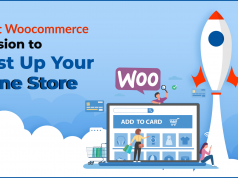“No thanks, I don’t need any more sales,” said absolutely no small business owner. Let’s be honest, hitting your sales goals can often be challenging, and most of us would welcome some help.
Building a business site is one thing, but making as many sales as you’d like is quite another. However, building on WordPress does give you a head start. There are loads of DIY WordPress website builder platforms out there, which make it easy to tweak your site until you find the ideal combination that converts visitors into loyal customers.
Managed WordPress hosting means that you can focus on driving traffic and converting leads instead of having to spend time and energy on website maintenance. Plus, WordPress is famous for its massive library of free and low-cost plugins, which between them offer all the functionality you could need to create an effective online sales engine.
All you need now are some top tips for WordPress sales success. Here are 7 tactics for increasing sales from your WordPress site.
1. Boost your site traffic
One of the simplest and most effective ways to improve your sales is to raise the number of people coming to your site. Even if your conversion rate stays exactly the same, more visitors = more conversions = more sales.
There are two main ways to boost traffic: by using pay per click (PPC) ads on Google Ads and social media channels like Facebook and Instagram, and by improving your SEO so that your website ranks higher on the search engine results page (SERP) when someone searches for your products or services.
You should be using both these tactics. There’s a lot to say about both PPC and SEO marketing, but here are some quick suggestions to get you started.
PPC marketing
Both Google and Facebook offer easy to use ad manager tools that help you to define your audience, choose the best layout and wording, and decide how often to show your ad. Remember to:
- Test every element of your ads, including image choice, text, and ad style
- Set ads to run for short periods of time so you can see which are the most effective, then double down on what works
- Always set a budget
- Include a clear call to action for every ad
- Try out different types of ads for different audiences to see which is the best target market.
SEO tips
Some of the best ways to improve your SEO include:
- Using a tool like Keywords Everywhere to check the best keywords for your business;
- Checking for broken links or “404-access denied” pages which drag down your ranking;
- Using a WordPress SEO plugin like Yoast that guides you to the optimal length for titles, checks for readability, and helps you add meta-text that search engines require;
- Making sure your website is mobile-first and responds to fit every device;
- Using long-tail keywords that mirror natural search language, like the way someone would search using voice search on a smartphone;
- Improving site load speed, which is now a key factor in the way that Google ranks websites;
- Adding alt tags to all your images.
2. Create a personalized experience

Today, it’s all about personalization. People want personalized beauty kits, personalized travel experiences, and personalized online shopping experiences too. One study reported that 72% of consumers only respond to personalized messages, and Deloitte reports that
80% of shoppers say they prefer brands that provide personalized experiences too.
It might seem tough at first to customize online shopping for each visitor, but it can be done. Using an AI-powered chatbot is one option. This way, you can have a one-on-one conversation with each customer, giving quick answers to their questions and making them feel cared for. Once again, there’s a plugin for that! (More than one, in fact.)
Another option is to offer product suggestions before they checkout, just like Amazon does. With the right plugin, you can recommend lawn fertilizer to the visitor who was looking at lawnmowers, clippers to the one who was checking out a pesticide that’s suitable for roses, and decorative plant pots to the customer with flower seeds in their cart.
3. Improve your marketing content

Today’s consumers rarely follow a simple linear journey. That is, it’s unusual for someone to decide to buy a lawnmower, for example, search for a lawnmower company, and buy a lawnmower from the first site they click on.
They are more likely to dip in and out of a number of lawnmower sites, read a few blog posts about what to look for in a lawnmower, and compare prices before they’re ready to buy, so people might come to your site and look around without having purchase intent.
By offering engaging content that delivers value and answers their questions about lawnmower ownership, you’ll be catering to their needs and helping build a relationship with them. When they are ready to buy a lawnmower, you’re likely to be the first place they turn.
Good marketing content is also your connection with existing customers. Encourage visitors and buyers to sign up to your email newsletters, and make sure that the emails you send are appealing, short, and add value. That way, you’ll ensure they remember your company and come back to you again in the future.
4. Enhance your website design

First impressions are everything, so website design really matters. Fully 90% of people say they’ve left a website because it was badly designed. If someone arrives on your homepage and finds it cramped, confusing, and with lots of flashing text and images, they’ll bounce straight off again.
The best advice is to keep it simple. Leave plenty of white space so that the webpage looks elegant and easy to read; use a clear, well-spaced font with a good contrast ratio; and include headings to make it easy to skim the text.
Choose your colors carefully; remember that if someone’s using a smartphone in bright sunshine, they’ll struggle to read something in yellow or light green.
All the same advice applies to your product description page. Include plenty of photos that show the product in a clear light and from every angle. If possible, add video, which is one of the best ways to make a sale. One study found that 84% of consumers decided to buy a product/service after watching a branded video.
5. Remove friction from the purchase journey
When someone comes to your site to buy a pair of shoes or make an appointment for a haircut, they don’t want to navigate a labyrinth of forms and popups. The more hoops you make your visitors jump through before they can checkout, the more likely they are to bounce off to a competitor with a simpler store.
It can be hard to spot flaws in your own site, so have a friend test it out for you and tell you about every point where they felt confused or found the process difficult. The customer should move intuitively from one page to the next, without having to hunt for hard-to-find purchase buttons.
One of the biggest turn-offs is when you get to the payment page, only to find a long form full of poorly-labeled fields. Keep the form to just a couple of fields, like name and email address, or better yet, offer a registration-free guest checkout option.
WordPress’ plugin library includes many easy to use payment plugins that simplify the checkout process, like WooCommerce or WP Simple Pay Pro.
6. Build Trust

Making a purchase online is a leap of faith, even if we’re no longer aware of it. Visitors to your site are subconsciously looking for reasons to trust you enough to hand over their credit card details and delivery address. If your website makes them feel skeeved out, they’ll try a competitor that’s more reassuring.
One way to build trust is to display reviews and testimonials from previous happy customers. They serve as social proof to reassure visitors that your products or services are going to meet their expectations. If you can, include headshots alongside testimonials, or even a video testimonial.
Security badges are another, and very important, element in this trust relationship. According to McKinsey, 87% of consumers won’t buy from a company if they have any concerns about its security. Consumers have heard enough horror stories about online payment fraud — and may even have been a victim themselves — that they prefer online stores with obvious security protection.
An SSL certificate that gives you an https:// web address is a minimum. It’s even better to use security from a trusted name like Norton Antivirus or Symantec. Place the logo of the security solution you use prominently on every purchase page, to increase confidence in your site.
7. Add payment options
The more payment options you offer, the easier you make it for your visitors to complete their purchase. That can mean going beyond PayPal to accept all credit cards directly on your site, or accepting digital wallets like Apple Pay or Google Pay.
Some small businesses are even starting to take cryptocurrencies like bitcoin for online payments. You might not be ready to take that step, and there are a number of pros and cons to consider before you do, but it’s a sign of where the market is going.
The right tactics can boost your WordPress site sales
It’s never easy to ramp up sales for your WordPress business site, but there’s always something you can do to make a difference. By improving your marketing content and web design, including social proof and security logos, adding more payment options, and making it easier for visitors to complete a purchase; increasing site traffic; and adding personalization, you can improve your sales rates to grow your business and boost your bottom line.






